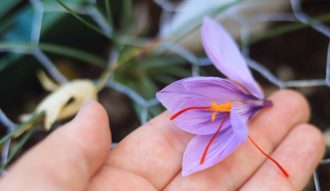Prized for the unique flavor it adds to rice dishes like paella and risotto, saffron is a legendary spice with global appeal. Saffron is harvested from the flower of Crocus sativus. The bright red stigma, also known as threads, are collected, dried and sold to chefs and homecooks worldwide. Grown primarily in southeastern Asia and the Mediterranean, saffron’s low yields and significant labor requirements can be daunting, but that is balanced out by its selling price, around $5,000/lb retail (North American Center for Saffron Research and Development, 2020). The price point and uniqueness of saffron attracted Rachel Tayse, who grows perennial berries, annual vegetables, and seedlings in central Ohio.
“Produce growers are faced with the challenge of harvesting enough highly-valued crops to create a financially sustainable farm,” said Tayse. “Saffron could be perennially profitable because both threads and mature bulbs can be sold.”
With support from a $14,927 SARE Farmer Rancher grant, Tayse worked with Kate Hodges of Foraged and Sown Farm to document and evaluate growing, weed management, harvesting, and storage practices for both in-ground and bench-grown saffron over two growing seasons.
Saffron grows from corms. Similar to a bulb, a corm is an underground stem which must be dug and divided every three to five years. Saffron corms require an average of four seasons to produce daughter corms of a size to harvest from or sell. Proper harvest, storage, and replanting of corms is part of the process of growing saffron.
Growing and Selling Saffron
Key Findings:
- Container production: Organic container production was preferred to field production. Saffron field production was more susceptible to weather and weed pressures. Container production yielded 3.5 times more flowers than field- grown.
- Weeds and pest pressure were minimal in container production.
- Harvest was simpler in containers raised to bench height.
- Yields: 2018 container production yielded 590 flowers from approximately 400 corms in 18 crates and 2019 containers yielded 796 flowers from 500 corms in 20 crates. An average yield per crate of 25 corms in container production, therefore, is 38 flowers (114 stigmas) in the first year. Each flower yields 3 stigmas/threads.
- Costs: Cost of production is slightly more than potential income in the first years. After year-one daughter corms have matured to productive size in year four, harvests will increase and the potential income will likely exceed cost of production.
- Marketing: They sampled saffron rice and handed out recipe cards (upper right) at a farmers market demo. Purchases of saffron increased around the winter holidays, and anecdotal conversations suggested customers most often purchased saffron as a gift. They charged $4 per package of 15 cured saffron threads, which is about 5 flowers worth.
“As a farm that was growing all niche, high-value, high-flavor products, expanding saffron into the farm’s production was a natural fit to explore,” said Hodges. “We were further convinced by saffron’s harvest season—it peaks just after the final harvests of our frost-sensitive herbs. The small amount of space required was another huge selling factor as a land-limited urban operation.”
Hodges says Foraged and Sown plans to continue offering saffron as a product.
“Our harvest in 2020 was just a handful of blossoms as the new corms of 2017-2019 continue to size up,” Hodges continued. “Next year, we’ll add new extra-large corms and hopefully those older corms will be large enough to provide blossoms.”
Dig Deeper
Read more about this SARE saffron project and view Tayse’s “Saffron Growing Guide”.
Watch two videos to see what they learned about this unique, high-value spice:
Growing Saffron in the Midwest
Saffron Harvesting and Processing
